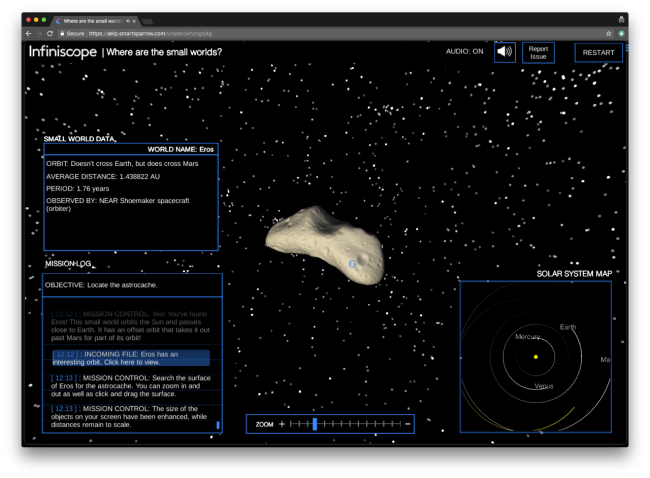You have /5 articles left.
Sign up for a free account or log in.

A screen shot from the Infiniscope project.
Smart Sparrow
Researchers at Arizona State University are on a mission to make science more appealing for K-12 students.
Funded by a $10.8 million, five-year grant from NASA, the university earlier this month launched a program that uses the agency’s real-world data to create engaging educational experiences targeted to students in middle and high school. The aim of the web-based Infiniscope project is to help prepare children for the type of analytical thinking that will be required of them in college science classes.
The free program already has more than 1,200 users, far exceeding the team’s goal for about 100 users this year, said Joe Tamer, assistant director of ASU’s Center for Education Through eXploration (ETX), which is leading the project.
“At the college level we really want to see kids coming from middle school and high school who are better trained in science concepts, and who get the mindset of problem-solving and engaging with the unknown, not just memorizing facts from a textbook,” said Ariel Anbar, the project’s deputy principal investigator and director of ETX.
The first Infiniscope module is a series of digital lessons and simulations designed to teach science through the exploration of space. Powered by NASA content and adaptive learning technology from San Francisco-based Smart Sparrow, Infiniscope is available to educators, students, parents and the general public.
The program draws on emerging research that shows that science is best learned through exploration rather than the rote memorization of facts. It presents information as a series of lessons, simulations and virtual field trips that engage students in learning by doing, said Dror Ben-Naim, ASU professor of practice and CEO and founder of Smart Sparrow.
"This is an exciting example of where digital learning is headed -- the best subject matter experts collaborating with creative instructional designers and engineers to create interactive experiences tailored to the needs of students," he said.
Model, Analyze, Interpret
The “Where Are the Small Worlds?” module teaches learners to use a model to make observations, analyze and interpret evidence as they explore small worlds -- bodies in the solar system that are not classified as a planet or a moon.
Through a simulated exploration of the solar system in search of asteroids and other objects, participants collect data on small worlds, observe the motion of different worlds to determine their location and launch probes to discover "astrocaches" hidden throughout the solar system. Users are guided along individual pathways, which adapt and provide feedback as they go.
The project makes the vastness of space and space exploration inviting, accessible and interactive for educators and learners of all ages, Anbar said.
"The aim is to help learners become problem-solvers capable of exploring the unknown, rather than just mastering what is already known,” he said. “Learning science should be approached as a process and as a universe of questions rather than as a dusty collection of facts.”
The learning modules can especially benefit smaller schools with limited resources or staff, said Ben-Naim. The program alerts teachers to topics that students have trouble with and prompts them to correct their mistakes.
“It’s like students go on a virtual field trip through space, and then they stop and get a little quiz,” he said. “If students answer incorrectly, they get feedback that tells them to go back to a certain part of the lesson to get more context for the right answer. It doesn’t just give them the right answer.”
The interactive nature of the lessons will be a hit with the video-game obsessed generation, Anbar said. “There’s a lot of doing in the experience, you’re not just sitting back and being passive,” he said.
Introduced at the National Science Teachers Association Conference in San Diego earlier this month, the module includes a lesson guide for K-12 educators and is aligned to work with middle and high school curricula. The project team plans to develop at least 15 more lessons on different space-focused topics over the next four years of the grant, Tamer said.
Trial and Error
The Infiniscope project has not been without challenges. The team had to align NASA content and space exploration themes with existing standards for middle school curriculum, which required some trial and error in the design of the program, Anbar said.
In addition, it wasn’t easy staying on time and within budget while ensuring that the program was educationally sound and compelling for students.
“Meeting all those goals required some iteration during design and -- more painfully -- after development was underway,” Anbar said. “It’s a creative process, and like all creative processes it is not always linear nor always predictable.
Infiniscope is part of the Inspark Science Network, a digital platform of educators from around the world who collaborate, create, customize and share next-generation exploratory activities. A joint initiative of the ETX Center and Smart Sparrow, the network was launched in 2015 with support from the Bill & Melinda Gates Foundation to create new digital courseware that helps students who typically fail science courses succeed.
The project perfectly aligns with the ETX Center’s mission, according to Anbar. “The idea is to build learning experiences around questions that explore ideas as opposed to telling students what the answers are, and Infiniscope is a great example of that,” he said.








